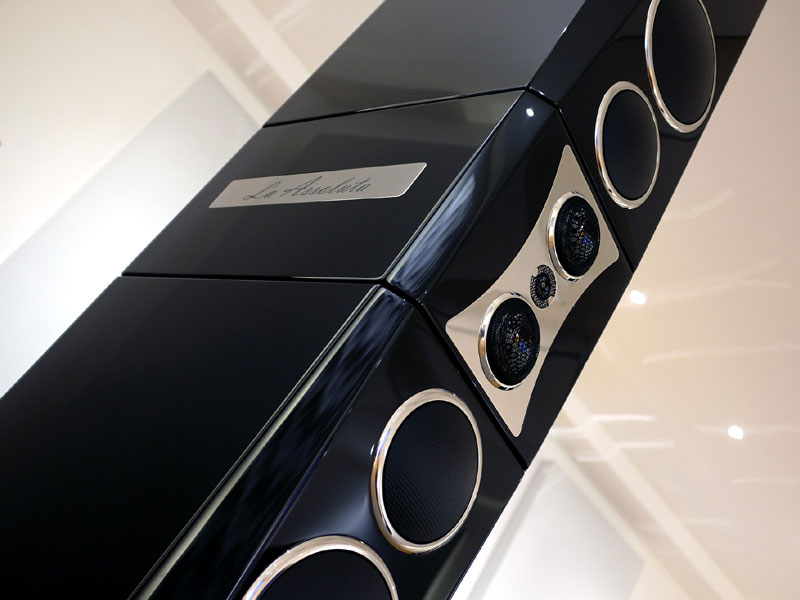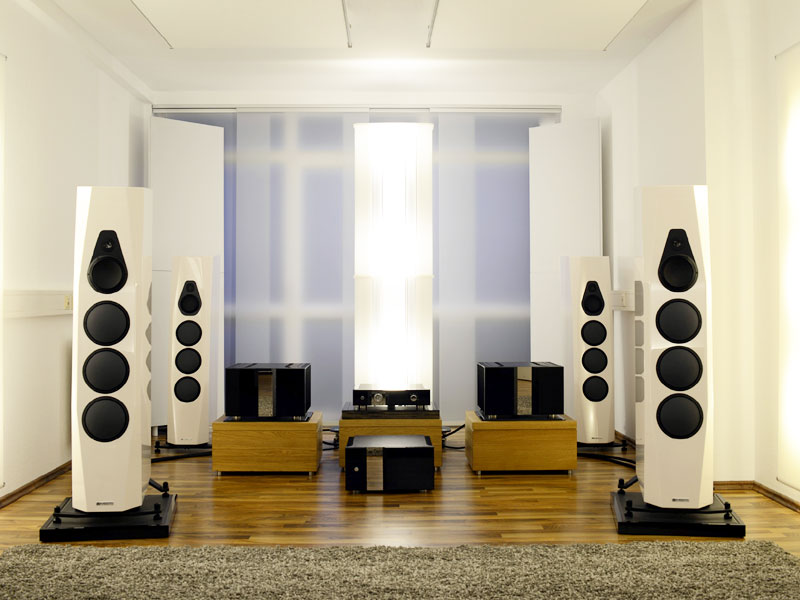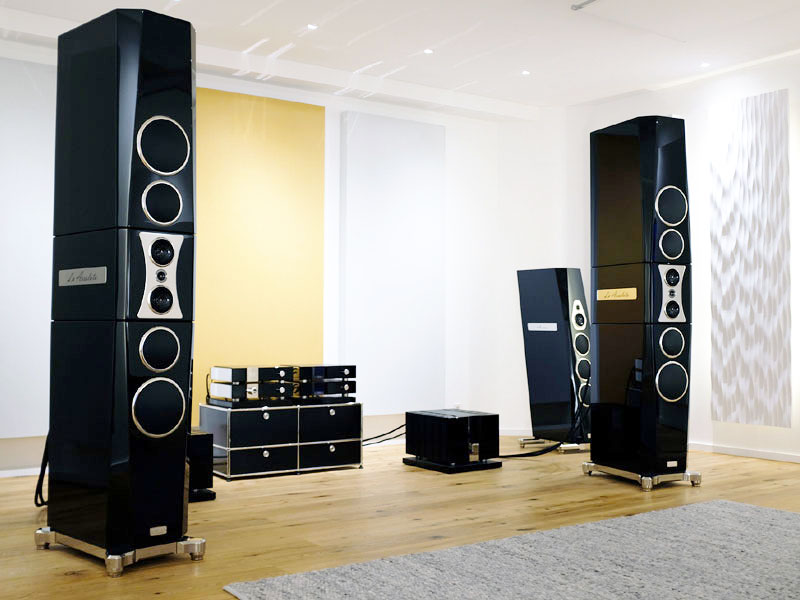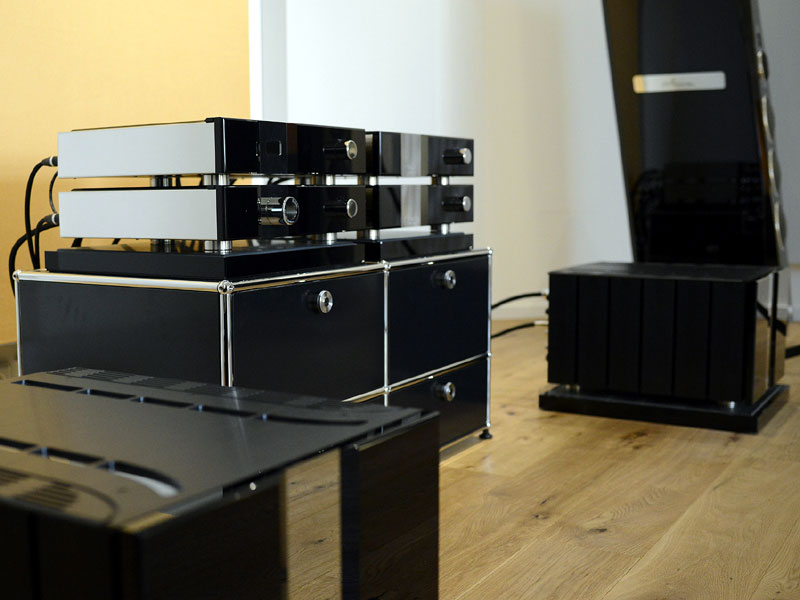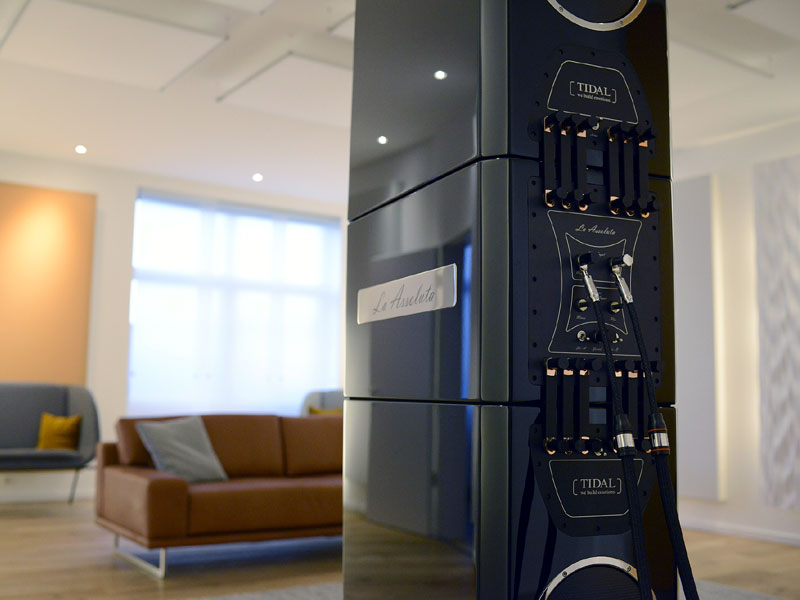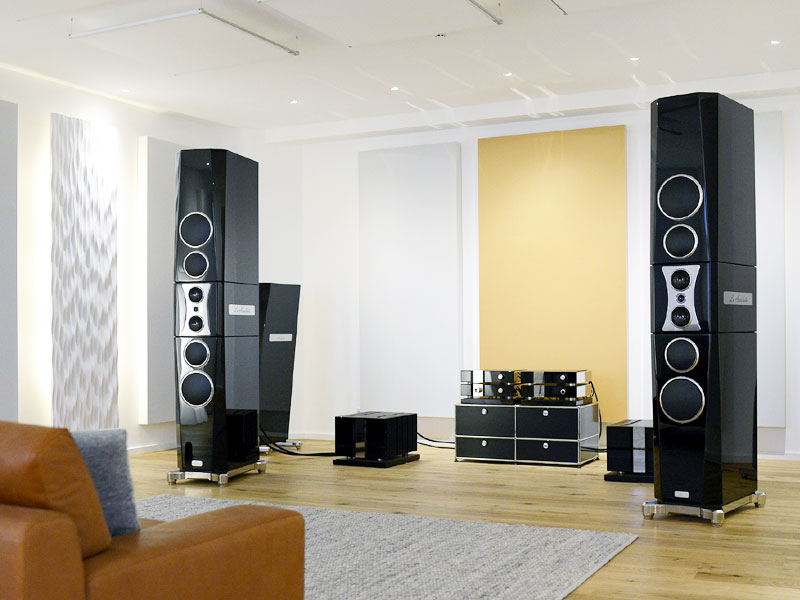Spending Time with Tidal's La Assoluta
This particular quest has been quite a journey, starting back before the 2014 Munich High End show, when Tidal’s Jörn Janczak first teased the audio world with images of a pair of 127mm/5" diamond-diaphragm midrange drivers, flanking a familiar-looking 30mm/1" Accuton diamond tweeter, culminating four and a half years later on a wind-swept December afternoon at the company’s headquarters in Hürth, Germany. Along the road there have been notable waypoints, including repeated brushes with the remarkable Akira, a less ambitious but still impressive speaker that uses just one of the diamond midrange drivers per side and which has managed to excel in situations as varied as the echo-y expanse of the MOC rooms in Munich and a Marriott bedroom at Rocky Mountain Audio Fest. Then there was the eventual debut of La Assoluta herself, a statuesque column sashaying into the public’s consciousness in Munich last year. That first glimpse might have barely hinted at the possibilities contained beneath that flawless exterior but was more than enough to set me on the path leading eventually to an interminable trek across Northern Europe (what is it about Belgian roads -- and Belgian traffic jams -- that seemingly makes them last forever?), terminating in this small town in Germany.
Tucked away down a narrow drive, the door to Tidal’s offices might be surprisingly modest, only a discrete logo and row of bells hinting at what's within, spread across two floors. The décor is unapologetically modern, airy and bright, with its pale walls, bare floors, discrete acoustical treatment and Scandinavian furniture. This is the company’s administrative center and showroom/listening space (production is carried out and stock held in a separate, far larger industrial facility nearby). There is a row of offices/design studios facing a long listening room on the second floor, and, not surprisingly, it’s here that you find the smaller, more manageable models: the Tidal Piano, and the Mino and Tonda from the new and more affordable Vimberg line.
But, as impressive as the Vimbergs are -- and they are seriously impressive -- that’s not why I was here. Downstairs, the entire footprint of the building is given over to a storage room, a meeting/display area and a single large listening room strangely reminiscent, at least in dimensional terms, of my old room in the UK. Here lives La Assoluta, alongside but dwarfing the Akira. Walk unsuspecting into the room and it’s quite an introduction. At a shade over 2.3m/7.5' tall and utterly upright, with no sloping baffle to soften the visual impact, she stands erect and aloof, solid, unmoving and unmovable, more like a skyscraper than a loudspeaker. The depth and mirror-like quality of the black lacquer, the seamless integration of polished stainless steel, the precision of the radiused edges and the subtle, tapering facets that relieve the otherwise bluff, vertical front face add up to a majestic, commanding presence. There’s no doubting the quality here. Tidal’s flagship tips the financial scales at €490,000 per pair. Each speaker is constructed from three separate cabinets, the central tweeter/midrange module top and tailed by a pair of symmetrical bass enclosures, each with 190mm/7.5" and 254mm/10" Accuton cell-series bass drivers, with aluminum honeycomb diaphragms, loaded by a pair of similar-construction 254mm/10" ABRs in the rear face. Despite the visual familiarity of these drivers (and others in the Tidal range), they are in fact custom built for the company in close cooperation with Accuton, a fact that reflects Tidal's status as Accuton’s biggest single hi-fi customer. Likewise, visit the production facility and it soon becomes apparent that the exacting attention to detail that is self-evident on the speakers’ exteriors extends well beneath their skins, from the proprietary laminated cabinet materials -- the latest Tiralit-Ultra in La Assoluta -- to the massive (and massively expensive) custom crossover components, the meticulous construction to the network of interlocking, internal braces. Each complete La Assoluta speaker weighs in at 485kg (the wrong side of 1000 pounds) and offers 93dB efficiency. These are no ordinary speakers -- and they deliver no ordinary performance.
But first it’s time to talk systems, because it’s impossible to listen to a loudspeaker without also listening to the system driving it and, once you reach these exalted levels of performance, the choice of that system is critical to the final results. La Assoluta was set up with a complete suite of Tidal electronics and cables (Presencio line stage, €65,000; Camira DMC DAC, €29,000; Assoluta mono amplifiers, €120,000 per pair; a mixture of Tidal Reference and soon-to-be-released Assoluta signal leads and power cords) all fed from an Esoteric P-02X CD/SACD transport (€25,900) chosen as a familiar benchmark rather than the last word in digital replay. Likewise, the setup was remarkably straightforward, the front-end components housed in a modified USM cabinet, the system devoid of such niceties as parallel, clean grounds and cable lifters. It’s not that Tidal’s Jörn Janczak is unaware of or dismisses such things, just that he wants to show a base level of performance -- "black coffee" as he puts it -- to which owners can add their own taste in sugar or sweetener, hot milk, half 'n' half or cream. It’s a view that echoes Dave Wilson’s use of Transparent speaker cables devoid of their network boxes, or Kevin Scott’s reliance on the (discontinued) Kondo Gaku-Oh amplifiers. For these designers, it’s not about presenting the ultimate possible performance, a single perfect solution. It’s about knowing where they are, where they have got to and where they are going. The color of the seats? That’s down to the individual passenger. So, even with La Assoluta, there are no absolutes.
Of course, the beauty of black coffee is that you really get to taste the beans, the roast and the grind -- and this La Assoluta system was no different. Like the speakers to which I am comparing the La Assoluta, there was an unmistakable sense of presence and substance, a "they are here" quality to the playing and the performers. But just like the Wilson WAMM MC and the Living Voice Vox speakers, La Assoluta also has her own specific character and qualities, traits that were immediately apparent, a performance based on clarity and a lucid sense of musical organization, unimpeded dynamic response and seemingly limitless headroom. Play the Barbirolli/Hallé Sibelius Symphony No.2 CD [Testament SBT 1418] and the complex, almost disjointed structure of the orchestration is both clearly apparent and bound unerringly together under Barbirolli’s imperious baton, with his masterful control of level and tempo. Those disparate interjections and contributions, the way the themes flit across the orchestra, hover on the fragile edge of disconnection, yet find their way back to build inexorably into towering crescendos, have a fundamental, almost preternatural quality. The Tidals perfectly capture the shifts in density and tonality, the sheets of color and the painstakingly careful construction and buttressing of those massive climaxes, the textural contrasts of woodwinds and strings, brass and timps. La Assoluta takes you inside the performance, gives you a new understanding of the orchestration, the musical sinews that bind this monumental musical event. Those imposing enclosures simply disappear, a visual gateway to the performance just beyond -- and never has that performance seemed so real, so reminiscent of the experience of sitting sixth row as the orchestra’s elements combine to such shattering musical effect. To appreciate the full-measure of the Tidal’s unforced clarity, musical authority and sheer rooted stability, look no further than Górecki’s 3rd Symphony on SACD (with the National Polish Radio Symphony Orchestra [Polski Radio PR SACD2]), its split sections and repeated, ponderous but unstoppable phrases that build with an awesome inevitability, layer on layer, orchestral section on orchestral section, half by half, swelling and burgeoning in power and irresistible intensity. Seldom has this most moving of pieces been quite so emotive and persuasive, propelling the listener toward that moment when soloist Zofia Kilanowicz starts to sing, her voice as beautiful as it is shatteringly powerful in its mournful intensity. Looking simply to get a measure of the system’s abilities when it came to bass definition, separation and texture, I found myself sucked into hearing out the entire 34-minute first movement -- and even then, it was a wrench to press the stop button. One reason for the convoluted journey to hear La Assoluta perform was a rendezvous in London to hear the remarkable Alena Baeva play the Tchaikovsky Violin Concerto with the LPO. Sitting down to hear Lisa Batiashvili play the same piece (Barenboim, Staatskapelle Berlin [Deutsche Grammophon Gesellschaft 0289 479 60386]) less than 48 hours later was always going to be a stern test for any system, but it was one that the big Tidal speakers met with unflappable aplomb, the results as impressive as they were revealing. The weight and impact of the orchestra, the fluid, expressive reach of Batiashvili’s playing were delivered with a combination of calm poise and controlled energy, an energy that left me in no doubt as to the available headroom, nor doubting the physical effort necessary on the part of the soloist, to drive a performance of such power and complexity. But there was more to it than that: Batiashvili’s uncanny phrasing, her measured approach to the opening bars of the solo part, her easy, fluid changes in pace and tempo throughout, her elongation of notes and the contrast with the suddenness of her attack were all revealed with effortless clarity. The sheer stability of the presentation lent presence and credence to the proceedings, as did the layered harmonics of the violin, the complexity of its sound, the double-stopped passages and rapid sprays of notes. Here was an almost perfect balance of power and delicacy, temporal control and perfect pitch, one that captured the sure lines and expressive range that make all her performances so dramatic and memorable. When I might have expected the conversation and perception to be dominated by the live-versus-recorded experience, it turned to the niceties of performance, Batiashvili as opposed to Baeva, Jurowski as opposed to Barenboim. La Assoluta bridged the gap, between performance and the performance, crossing the gulf between recording and suspended disbelief, facsimile and almost reality. Almost? Yes, almost -- for this was also the recording that first started to reveal limits in the system’s performance. For all her presence and rock-like stability, La Assoluta couldn’t match the dimensionality and coherent acoustic space I’ve heard projected by Wilson’s WAMM MC, nor the intimacy, microdynamic discrimination and sense of human agency that define the Living Voice Vox Olympian or Vox Palladian. To a great extent I think that this reflects the performance of the Esoteric transport rather than the rest of the system, especially when it comes to the issues of intimacy, agility and articulation; just as the three-dimensionality of the Wilson rig reflects the transparency and spatial stability of the dCS Vivaldi front-end and D’Agostino amps, or the extraordinary insights into note weight and bow pressure delivered by the Living Voice setups reflect the presence of the Wadax Atlantis DAC and Engström Lars amplifiers. But nor do those systems match the astonishing presence, natural separation and tonality that typify the Tidal system. Each has its specific strengths and individual musical perspective, just as a concert hall has stalls, a balcony and boxes. But what is more important than the differences is what all of these speakers share -- an innate grasp of the temporal domain, the ability to make things happen where and when they should, to reveal both the sense and sensibilities in the music. La Assoluta’s combination of assured timing, solid presence, tonal discrimination and projected energy makes for spectacular rock and pop performances. Morphine’s familiar "Buena" (from the Cure For Pain CD [Rykodisc RCD10262]) had new urgency, shape and purpose, bringing a potent, almost malignant presence and drive to the room, the tactile shape and substance of the bass line, the raucous texture and jagged prompts of the sax sparring with the vocals and bringing back the raw edge of excitement I felt when I first heard this track. I must have played the Cure’s Seventeen Seconds [Fiction 982 183-1] hundreds of times, but never have the vast space, stark clashing interjections and that motive, propulsive drum-and-bass line enjoyed such clarity and purpose. Never have the evolving shape and repetitive nature of the low frequencies been such an obvious precursor to the hypnotic sequencing of trance and other electronica. It all made the music an irresistible, heaving tide that propelled me onward. With no sense of bandwidth or headroom limitations, with unlimited energy seemingly on tap, the densely layered mix just gained shape and substance as each track built. But this wasn’t just an exercise in raw power: play the title track and listen to the distinctive sounds of each carefully measured drum beat, the rattle of beads against the cymbal, the layering of the individual guitars (not to mention the understated brilliance of Robert Smith’s playing) and you quickly realize that this is a system that invites you inside the music. You might have heard "Seventeen Seconds" a hundred times or more, but you’ve never heard it like this. One thing that quickly emerges but which is underlined by the playing of rock or pop tracks is the absence of glare or hardness, of any brittle edge to the sound. The ripping textures of Dana Colley’s sax on "Buena" are there in his playing, just as the halo of brightness that surrounds Smith’s slashing guitar lines is utterly intentional. La Assoluta reveals and resolves, but doesn’t enhance or gild the musical lily. It’s the other side of the speaker’s astonishing tonal neutrality and separation, its refusal to collapse or compress musical or tonal distinctions. It also helps explain why, as effortlessly revealing and transparent as this system is, it’s also so relaxing and utterly fatigue-free in action. This really is a system that I could listen to all day -- and then the next. If music is all about pitch and pattern, then this is a near-perfect response, with its effortless clarity and structure, whether it’s the formal order in the orchestration of the Beethoven 1st Piano Concerto or the repetitive rhythms of the Cure’s "Seventeen Seconds." Through the window offered by La Assoluta, at least on the end of this system, Benedetti Michelangeli’s playing [Deutsche Grammophon Gesellschaft 289 449 757-2] leans more to power and precision than delicacy and fluidity of phrasing, emphasizing the relationship of soloist to orchestra rather than left to right hand (as with the Vox Palladian) or the event as a whole (as with the WAMM MC). Curzon’s Mozart on SACD [Esoteric ESSD 90014] is full of body and substance, its elegant lines unmistakable but lacking that frisson of note-to-note intimacy, subtlety and infinite variation. But in both cases, the piano is an almost physical entity in the room, never less than purposeful, with weight and stability that most systems can’t even hint at. That is both the beauty of black coffee and where the milk and sugar come in. I can’t help but wonder what the Wadax Atlantis front-end would have brought to the La Assoluta experience -- or records replayed on the Grand Prix Monaco 2.0 turntable, a product that might have been designed as a perfect fit for the Tidal system. I’m confident that combining the attributes of my chosen (or make that preferred) sources with the lucid clarity and sheer presence of La Assoluta and the Tidal amplifiers would have slanted the system's performance my way, tailoring its response even more closely to my musical demands. At concerts, I sit front and center, a seating position that delivers direct energy, separation and structure to the music. La Assoluta’s effortless tonal and spatial separation, musical substance and harmonic complexity are immediately recognizable, a clarity that makes lesser speakers and systems sound cluttered and congested, in the same way that live music compares to most recordings and replay. This clarity, this presence, and this effortless musical communication are La Assoluta’s particular talents; how you shape those talents is up to you. I know the Esoteric transport, what it does and what it doesn’t do in musical terms. Both its strengths and its weaknesses were laid bare by the Tidal system, not in a destructive or distracting way, but simply in the style of the presentation and the gates on the performance. La Assoluta leaves no room for doubt, either in terms of the performance of the system or the performance of the music. So far, most of the examples I’ve cited have erred to the larger end of the musical spectrum. But lest you get the impression that La Assoluta is a musical bully, interested only in scale and projecting power, let me reassure you that these speakers do small too -- and do it to breathtaking effect. The speaker was named for Maria Callas, so I thought at first it was slightly ironic that a speaker that’s so demonstrably correct should honor a singer revered for her emotive qualities rather than her technique. But play a vocal, any vocal, and the Tidal’s expressive range and directness of communication are immediately apparent, whether it’s an operatic aria, grunge metal or girl and guitar. It’s telling that the most abiding memory of my time spent with La Assoluta involves singers I know well, captured live and acoustic. Duets [no catalogue number] is a concert-only CD-R released by Steve Dawson and Diane Christiansen (of Dolly Varden). It's a mix of studio one-takes and concert recordings, and the achingly beautiful version of "The Thing You Love Is Killing You" has an immediacy and intimacy that are rare, but which, in the capable hands of Tidal’s finest, blossom into an almost ghostly reality, bringing living, breathing, life-sized performers to occupy the space behind and between the speakers. It’s not just that the speakers put the performers in the room, but that they bring performance and room together, including you in the space where the performance occurred: just as with the Sibelius -- but on an even more intimate, up-close-and-personal level.
By now it should be apparent that the
Tidal flagship delivers on its promise, sitting squarely between the competing musical
attributes of the Wilson and Living Voice speakers, matching them for quality but offering
its own distinct character and musical perspective. Not exactly a linear continuum, the
three take up more of a flattened, triangular formation, each pulling in its own distinct
direction while at the same time coexisting on a single qualitative plane. The world
isn’t exactly short of absurdly expensive speaker systems (and these three -- or four
-- are actually far from the priciest), but the WAMM MC, Vox Olympian and Vox Palladian,
and now the Tidal La Assolutas are all significantly ahead of the competition. The big two
has become the big three, and nothing else that I have heard comes close. La Assoluta was
way more than worth the wait. |

